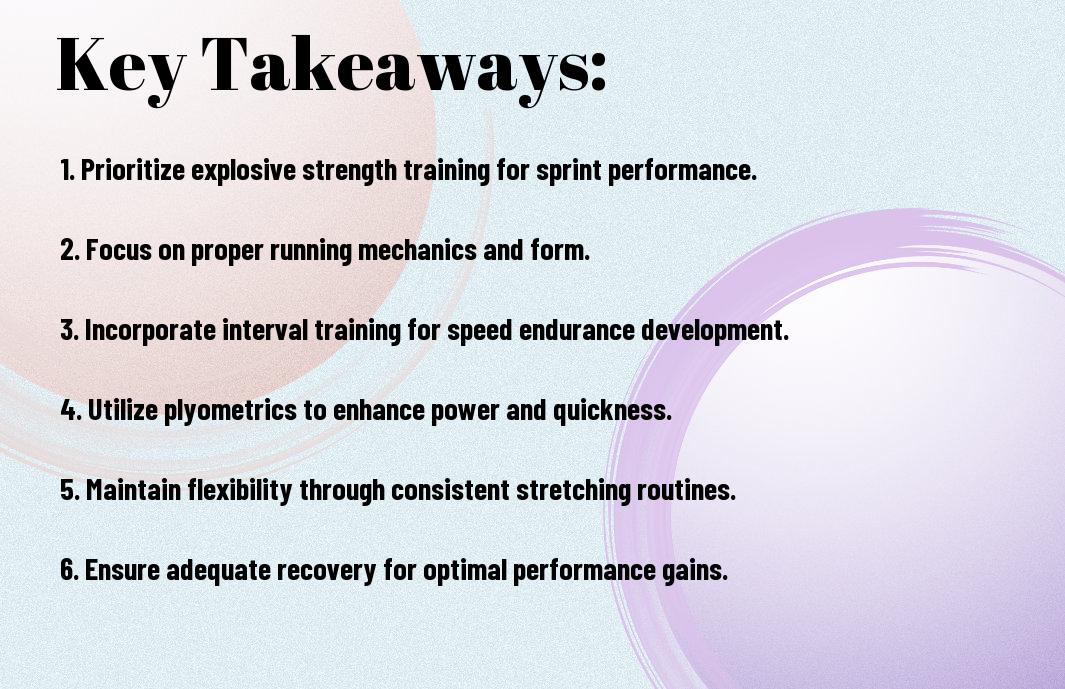You can enhance your speed through effective resistance training techniques that target the muscles crucial for quick movements. By incorporating varied weights and focusing on explosive exercises, you’ll build strength and power, which directly translates to faster performance. Research shows that specific resistance training methods can lead to significant improvements in sprinting speed and overall athleticism, as outlined in The Effects of Different Relative Loads in Weight Training …. This guide will walk you through the best practices to optimize your training for speed gains.

Key Takeaways:
- Choose the Right Exercises: Focus on compound movements like squats, deadlifts, and lunges to enhance overall strength and stability.
- Implement Plyometrics: Incorporate explosive movements such as box jumps and jump squats to increase power and speed.
- Optimize Repetition Ranges: Use lower rep ranges (1-5) with heavier weights to build maximal strength, which translates to improved speed.
- Maintain Proper Form: Prioritize form over weight to prevent injuries and ensure effective muscle engagement during resistance training.
- Integrate Rest and Recovery: Allow adequate time for recovery between sessions to facilitate muscle adaptation and enhance performance.

Understanding Resistance Training
Before you explore improving your speed, it’s vital to grasp the fundamentals of resistance training. This form of exercise involves exerting force against a resistance, which can be free weights, resistance bands, or your own body weight. By incorporating resistance training into your routine, you can build muscle, enhance strength, and ultimately boost your athletic performance.
Definition and Principles
Against popular belief, resistance training is not solely for bodybuilders. It is a methodical approach to enhance muscular strength and endurance through progressive overload, where you gradually increase the weight or intensity to challenge your muscles. Understanding this principle is key to leveraging resistance training effectively.
Benefits for Athletes
At its core, resistance training provides athletes with numerous benefits, including improved power, speed, and overall athletic performance. By developing your strength through resistance exercises, you increase your ability to produce force quickly, enhancing your explosive movements during various sports.
Principles of resistance training, such as specificity and overload, play a significant role in how it benefits athletes. These principles ensure that your training is tailored to the demands of your specific sport, allowing you to target muscle groups and energy systems that directly correlate to your performance. Consistent resistance training also contributes to injury prevention by strengthening ligaments and tendons, making you more resilient during high-intensity activities. By integrating these principles into your regimen, you can maximize your potential to improve speed and agility.
The Relationship Between Speed and Strength
If you want to boost your speed, it’s important to understand that strength plays a significant role in athletic performance. Stronger muscles generate more force, enabling you to push off the ground with greater power. Enhanced strength allows you to sprint more efficiently, as it contributes to better acceleration and higher top speeds. By integrating resistance training into your regimen, you can optimize both your strength and speed, leading to improved overall performance.
Muscle Fiber Types
The muscle fibers in your body significantly influence your speed capabilities. There are generally three types of muscle fibers:
| Muscle Fiber Type | Description |
| Type I | Slow-twitch, endurance-focused |
| Type IIa | Fast-twitch, versatile for power and endurance |
| Type IIb | Fast-twitch, primarily for explosive strength |
| Hybrid | Combination of different fiber types |
- Type I fibers help in prolonged activities but offer less speed.
- Type IIa fibers strike a balance for both speed and endurance.
- Type IIb fibers excel in quick, explosive movements needed for sprints.
- Muscle fiber composition can vary among individuals.
- This understanding allows you to tailor your training program effectively.
Power Development
Power is a critical component in enhancing your speed, combining both strength and speed in explosive movements. By focusing on improving your power-generating capabilities through resistance training, you’ll enhance your ability to sprint faster and react quickly in athletic scenarios. This involves exercises that emphasize fast, explosive lifts and plyometric movements that condition your muscles to produce peak force in minimal time.
Fiber types in your muscles determine how quickly and powerfully you can respond in athletic activities. Fast-twitch fibers (like Type IIa and IIb) are important for high-intensity movements, such as sprinting. Therefore, performing resistance exercises that engage these fibers will further develop your explosive power. Implementing plyometric drills alongside strength training can help maximize your overall speed during performance. By aligning your training strategy with your unique muscle fiber composition, you can optimize speed and power for superior athletic results.
Designing a Resistance Training Program
Many athletes can benefit from incorporating a well-structured resistance training program into their training regimen. To optimize your speed, consider integrating exercises that enhance both strength and power. For guidance on key exercises, check out Strength Training For Increased Speed And Power.
Setting Goals
Among the first steps in designing your resistance training program are setting specific, measurable, attainable, relevant, and time-bound (SMART) goals. Outline what you aim to achieve, whether it’s improving your sprint times or increasing your explosive strength. Having clear goals helps you stay focused and motivated throughout your training journey.
Exercise Selection
Exercise selection is vital for a successful resistance training program aimed at improving speed. You should choose movements that specifically target the muscles utilized in sprinting and other high-speed activities. Opt for exercises like squats, deadlifts, and plyometrics that promote both strength and explosive power, ensuring they align with your speed goals.
Further, consider incorporating compound movements that engage multiple muscle groups, as this promotes functional strength. Balance heavy lifting with dynamic exercises to improve both strength and speed. Incorporating Olympic lifts can also enhance your power output, leading to improved sprinting performance. Personalizing your exercise selection will be key to reaching your speed goals effectively.
Key Exercises for Speed Enhancement
Keep your training varied and incorporate key exercises designed to target strength and speed simultaneously. Focus on movements that engage your muscles dynamically and challenge your body through different planes of motion. By strategically applying these types of exercises into your routine, you’ll pave the way for optimal speed enhancement.
Squats and Deadlifts
Around these foundational exercises, you can develop powerful lower body strength vital for burst speed. Squats target your quads, glutes, and hamstrings, whereas deadlifts engage your posterior chain. By including these lifts in your program, you build overall strength that translates well into improved sprint mechanics and acceleration.
Plyometrics and Olympic Lifts
Any resistance training program aimed at boosting speed should incorporate explosive movements like plyometrics and Olympic lifts. These dynamic exercises help develop fast-twitch muscle fibers critical for sprinting and agility.
Plus, plyometrics, such as box jumps and depth jumps, enhance your ability to apply force quickly, while Olympic lifts like the clean and jerk build explosive power. Integrating these exercises fosters a stronger kinetic chain, significantly contributing to faster starting speed and improved acceleration on the track or field.
Incorporating Resistance Training into Your Routine
To effectively enhance your speed, you should integrate resistance training into your existing workout regimen. Focus on compound movements such as squats, deadlifts, and lunges, as they engage multiple muscle groups. Aim for two to three sessions per week, ensuring you balance your training with adequate speed drills to maintain your sprint technique. This combination will help you achieve optimal speed gains while minimizing the risk of injury.
Frequency and Recovery
Resistance training should be scheduled with careful consideration of your overall workout frequency and recovery. Engage in resistance workouts two to three times per week, allowing sufficient recovery days in between sessions. Recovery is necessary for muscle growth and performance improvement; hence, listen to your body and prioritize rest as needed to perform at your best.
Combining with Speed Work
Incorporating resistance training with your speed workouts can significantly amplify your results. Balance your resistance sessions with sprint drills to ensure that you develop both strength and speed without sacrificing technique. Focus on explosive movements and plyometric exercises, as they will translate well into improved sprint performance. Tailor the intensity and volume of your resistance training to complement your speed sessions for optimal benefits.
A well-structured training plan that incorporates both speed work and resistance training ensures that you build strength while also honing the neuromuscular adaptations necessary for sprinting. For instance, following a heavy lower-body day with dynamic speed work, such as hill sprints or interval training, can stimulate your muscles effectively. Additionally, incorporating exercises like box jumps or kettlebell swings can enhance your power output, making your movements more explosive on the track. Adjust the timing, intensity, and nature of your workouts based on your goals to achieve the best results.
Monitoring Progress and Adjusting the Program
Your success in using resistance training to enhance speed relies heavily on monitoring progress and making necessary adjustments to your program. Regularly assessing your performance and adapting your training regime ensures that you remain challenged, continuously improving your strength and speed. This dynamic approach not only helps in achieving specific goals but also keeps your training engaging and effective.
Performance Metrics
To effectively monitor your progress, identify and track specific performance metrics, such as sprint times, agility drills, and strength exercises. Utilize tools like stopwatches or fitness apps to record your results regularly, providing concrete data to inform your training decisions. Consistent tracking enables you to recognize patterns in your performance, helping you tailor your resistance training program to meet your evolving needs.
Feedback and Re-evaluation
To ensure your program remains effective, seek feedback and regularly re-evaluate your training plan. Engage with a coach or knowledgeable training partner who can offer insights into your form and technique. Additionally, reflect on your personal experiences and performance outcomes to identify areas that may require modification.
Also, when you actively seek feedback, you create opportunities for improvement and growth. Pay attention to how your body responds to different exercises and intensities. If you notice stagnation in your progress or experience discomfort, it may be time to adjust your routine or incorporate new techniques. Regularly re-evaluating your goals and performance not only enhances your training efficiency but also keeps you motivated on your journey to improved speed.
To wrap up
Conclusively, incorporating resistance training into your routine can significantly enhance your speed. By focusing on exercises that target the muscles used in sprinting, such as squats and deadlifts, you build strength and power. Additionally, maintain a balance between resistance training and aerobic workouts to support endurance. Track your progress and adjust your training plan as needed to continue challenging your body. Through consistent effort and attention to form, you’ll notice improvements in your speed, leading you to perform better in your athletic pursuits.
Q: What is resistance training and how does it impact speed development?
A: Resistance training involves performing exercises that improve strength and muscle endurance using weights, resistance bands, or body weight. It impacts speed development primarily by enhancing muscle strength and power, which are crucial for faster sprinting. By increasing the force your muscles can exert, resistance training can help improve your overall athletic performance, allowing you to sprint with greater speed and efficiency.
Q: Which specific resistance training exercises are best for improving speed?
A: The best resistance training exercises for improving speed include squats, deadlifts, lunges, and plyometric exercises like box jumps and sprints with resistance. These exercises engage the major muscle groups used in sprinting and help in developing explosive strength, which translates into faster acceleration and improved top speeds on the track or field.
Q: How often should I incorporate resistance training into my speed training routine?
A: It is recommended to incorporate resistance training into your routine 2 to 3 times a week, depending on your training goals and overall workout schedule. Ensure to leave enough time for recovery, as your muscles need rest to rebuild and grow stronger. It’s crucial to balance resistance training with speed work to maximize performance gains without risking injury.










